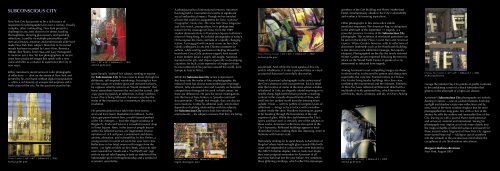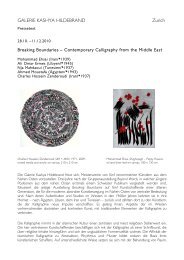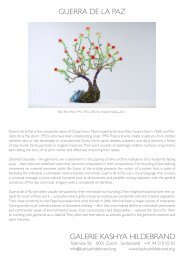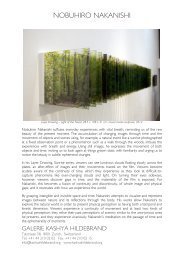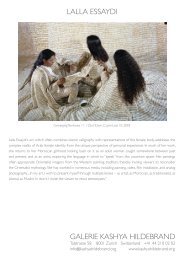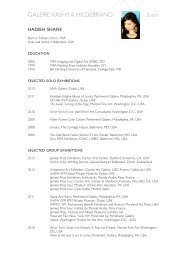JEFFREY AARONSON - Steiner Graphics
JEFFREY AARONSON - Steiner Graphics
JEFFREY AARONSON - Steiner Graphics
Create successful ePaper yourself
Turn your PDF publications into a flip-book with our unique Google optimized e-Paper software.
SUBCONSCIOUS CITY<br />
New York City has proven to be a rich source of<br />
inspiration for photographers for over a century. Visually<br />
complex, often confounding, New York presents a<br />
challenge to any artist drawn to its dense, bustling<br />
thoroughfares, dizzying glass towers, and sparkling<br />
reflections. Lured by its multiple personalities and<br />
mercurial beauty, amateurs and professionals alike have<br />
made New York their subject. Street life in its myriad<br />
moods has been recorded by Lewis Hine, Berenice<br />
Abbott, Ben Shahn, Ernst Haas and Gary Winogrand,<br />
to mention just a few. Yet few photographers in recent<br />
years have produced images that speak with a new<br />
voice and offer us a chance to experience the City in<br />
new ways.<br />
Jeffrey Aaronson’s recent series of color photographs<br />
of reflections — shot on the streets of New York and<br />
printed by his own hand without digital manipulation<br />
— offers a rich bounty of unexpected surprises and a<br />
fresh vision of the city. For the past two years he has<br />
Winter Garden | 60” x 40” | Edition of 5 | 2002<br />
Archival giclée print<br />
Saks | 42” x 28” | Edition of 5 | 2002<br />
Archival giclée print<br />
quite literally “stalked” his subject, seeking to expose<br />
the Subconscious City he has come to know through his<br />
deliberate, self-imposed wanderings. Focusing his lens<br />
at close range on window glass and mirrored surfaces,<br />
he captures what he refers to as “found moments” that<br />
hover somewhere between the real and the surreal. Like<br />
a spy glancing quickly at reflections in shop windows<br />
to see if he is being followed, Aaronson searches the<br />
realm of the immaterial for a momentary discovery or<br />
revelation.<br />
His perambulations have taken him from east to<br />
west and from lower Manhattan to midtown. As the<br />
cityscape passes before him, a multi-layered portrait<br />
of the City emerges — from the elegant windows of<br />
Bergdorf’s, Prada and Saks to a crowded souvenir shop<br />
in Times Square. Here, in the faces of people frozen<br />
within his reflected scenes, are fragmented, chance<br />
narratives of rich and poor, contentment and desire,<br />
anxiety, alienation, and vulnerability. In Bus Shelter, a<br />
young woman in a print ad averts her eyes from view.<br />
Reflections in her head swarm with images from the<br />
street – car lights twinkle on her cheek, a bicycle rider<br />
veers towards her mouth and a “Get Paid Cash” sign<br />
with its tear-off tabs flapping is both an emblem of the<br />
indomitable spirit of entrepreneurship and a symbol of<br />
economic uncertainty.<br />
A photojournalist of international renown, Aaronson<br />
has long held a fascination for events of significant<br />
social and political impact. Though he has traveled<br />
all over the world on assignments for Time, National<br />
Geographic, Vanity Fair, The New York Times Magazine<br />
and Newsweek, among others, he is perhaps best<br />
known for his coverage of China. From the 1989<br />
student demonstrations in Tiananmen Square to Britain’s<br />
return of Hong Kong, his colorful photographs of today’s<br />
China expose the many contrasts of a rapidly changing<br />
nation: A young girl with incense cones on her chest<br />
calmly undergoes an ancient Chinese treatment for<br />
asthma, while smiling waitresses in Beijing dressed in<br />
brand-new Coca-Cola uniforms eagerly look toward<br />
a more modern future. Largely self-taught, Aaronson<br />
learned on the job, and, drawn especially to developing<br />
countries, he built a vast repertoire of images of those<br />
he encountered on his journeys around the world, from<br />
Europe to Asia to Africa.<br />
While the Subconscious City series is Aaronson’s<br />
first foray into the realm of fine art photography, his<br />
editorial work has always transcended pure reportage.<br />
Vibrant, fully saturated color and carefully orchestrated<br />
compositions distinguish his work in both arenas. Yet<br />
there are differences. He sees his recent investigations<br />
into the lives of New Yorkers as “pseudo-contrived<br />
documentaries.“ Though real enough, they are also his<br />
own creations. Unlike his editorial work, which often<br />
depends on building relationships with his subjects,<br />
the Subconscious City series finds him shooting<br />
anonymously – his subjects unaware that they are being<br />
Ta Bom Ties | 53” x 80” Edition of 5 | 2003<br />
Digital chromogenic print<br />
Dinos Parking Garage | 40” x 60” | Edition of 5 | 2002<br />
Archival giclée print<br />
scrutinized. And, while the work speaks of this city<br />
and its inhabitants, it is also a personal diary or visual<br />
account of Aaronson’s own daily discoveries.<br />
Many of Aaronson’s photographs in this series reveal<br />
the City’s obsession with consumerism. Each is titled<br />
after the location or name of the store whose window<br />
is featured. In Saks, an elegantly attired mannequin in<br />
needle-sharp, high-heeled shoes presents a startling<br />
contrast to the casually-dressed family of three who<br />
stroll into her rarified world from the teeming street<br />
outside. Prada — with its jumble of complex layers of<br />
reflections — brings us face-to-face with a windowwasher<br />
inside the store. Headless mannequins appear<br />
to be breaking through the boundaries of the vast<br />
expanse of glass. While the clash between the City’s<br />
have’s and have-not’s is certainly one of the subjects in<br />
these works, Aaronson’s reflections also speak of the<br />
City’s humanity. Reflected buildings appear to have<br />
diminished in size, making them less imposing, more in<br />
harmony with human scale.<br />
Particularly striking for its quiet beauty is Raindrops at<br />
Bergdorf where hand-wrought glass vessels filled with<br />
water and suspended at various levels were featured in<br />
the 2002 Christmas display. Like so many tear drops,<br />
they were poignant reminders for Aaronson of all<br />
that New York had lost the year before. Yet, somehow<br />
these glittering raindrops, which reflect the statuesque<br />
grandeur of the GM Building and Sherry Netherland<br />
Hotel, simultaneously allude to the City’s vulnerability<br />
and reinforce its towering aspirations.<br />
Other photographs in this series elicit similar<br />
emotional responses. The American flag, so ubiquitous<br />
in the aftermath of the September 11 tragedy, is a<br />
powerful presence in many of the Subconscious City<br />
photographs. This evidence of newfound patriotism can<br />
be seen in Rockefeller Plaza, Grand Slam and American<br />
Express. Winter Garden, however, with its reflections of<br />
downtown landmarks such as the Woolworth Building,<br />
is less obvious in its subliminal message, but equally<br />
eloquent. Photographed on the day the newly restored<br />
Winter Garden atrium reopened following the terrorist<br />
attack on the World Trade Center, it speaks of a city<br />
determined to rebound from tragedy.<br />
Among Aaronson’s most compelling images are those<br />
in which reality is obscured by pattern and abstraction<br />
supercedes the concrete. Framed mirrors in Chelsea<br />
Flea Market bring nearby buildings into close view,<br />
conflating the monumental and the intimate. Similarly,<br />
Ta Bom Ties fuses reflected architectural detail with a<br />
multitude of richly patterned ties, which become one<br />
with bricks, doors, windows, and sky. In Dino’s Parking<br />
Bus Shelter | 42” x 28” | Edition of 5 | 2002<br />
Archival giclée print<br />
Chelsea Flea Market | 42” x 28” | Edition of 5 | 2002<br />
Archival giclée print<br />
Garage the familiar Day-Glo palette of graffiti conforms<br />
to the undulating curves of a black Mercedes that<br />
glistens in the aftermath of a light rain shower.<br />
Aaronson’s Subconscious City photographs are entirely<br />
fleeting in nature — one-of-a-kind moments. Each day<br />
sunlight and shadow create new reflections and by<br />
now, most of the store window displays that he once<br />
photographed are long gone. Yet, with a click of the<br />
shutter, he stills the restless and inexorable flow of the<br />
City, leaving us with a journal that is both personal<br />
and universal, material and immaterial. Seeing his<br />
photographs may inspire us to look more closely into<br />
the magical depths of reflected surfaces and search for<br />
those instants when fragments of New York City appear<br />
more surreal than real — taking us out of ourselves<br />
into the solitude of the unconscious mind where the<br />
cacophony of city life dissolves into silence.<br />
Margaret Mathews-Berenson<br />
New York, August 2003


